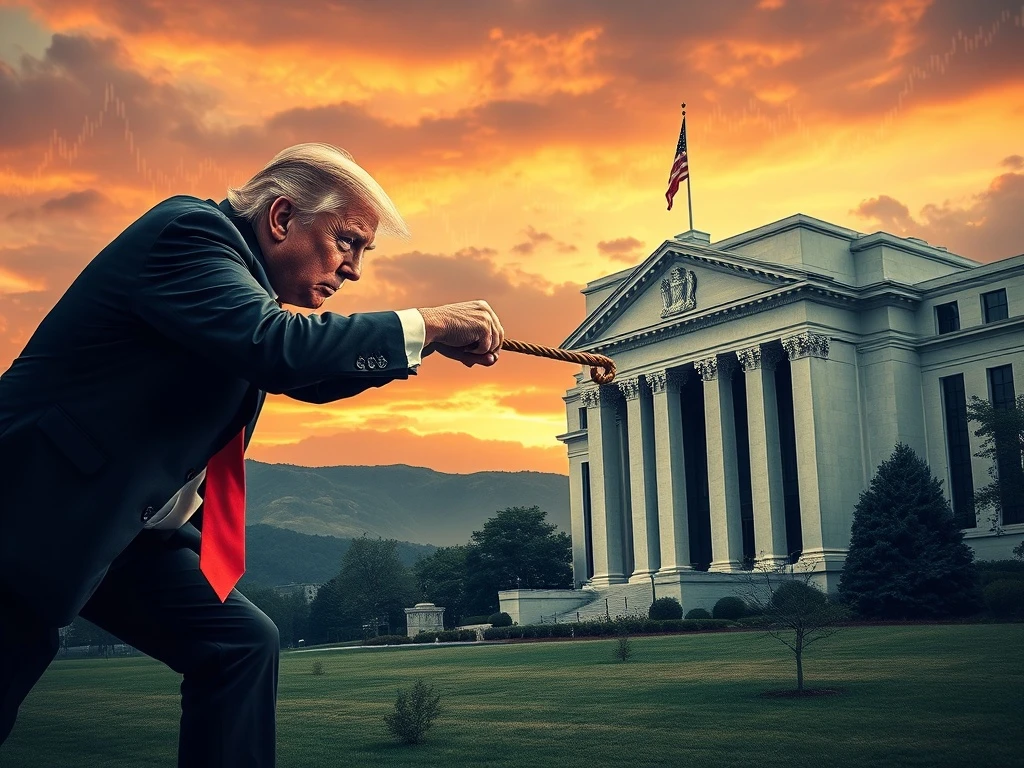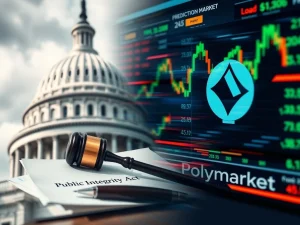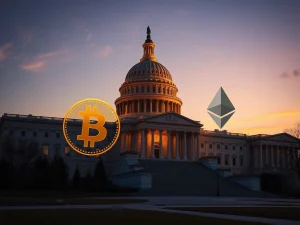Crucial Showdown: Trump’s 3% Rate Cut Demands vs. Federal Reserve Independence

In the ever-evolving world of cryptocurrency, market movements are often a direct reflection of broader economic currents. One of the most significant forces shaping these currents is the Federal Reserve’s monetary policy. When political figures like former President Donald Trump publicly challenge the Fed’s decisions, especially concerning interest rates, it sends ripples not just through traditional finance but also through the volatile crypto markets. This article delves into a pivotal moment where Trump’s aggressive push for a 3-percentage-point rate cut brought the critical issue of Federal Reserve independence into sharp focus, revealing the delicate balance between political influence and economic stability.
The summer of 2025 witnessed a dramatic escalation in the long-standing tension between political leadership and the U.S. central bank. Former President Donald Trump’s visit to the Federal Reserve headquarters on July 3, 2025, wasn’t just a routine meeting; it was a highly publicized event that intensified scrutiny on the relationship between the White House and monetary policy. Trump, known for his direct approach, reiterated his demand for a substantial 3-percentage-point reduction in interest rates, a move he believed would significantly boost the American economy. This push put him squarely at odds with Fed Chair Jerome Powell, who firmly reaffirmed the central bank’s unwavering commitment to its independence. The encounter, marked by Trump’s candid remarks and even a lighthearted slap on Powell’s arm, highlighted a deeper debate about who truly steers the nation’s monetary policy and the potential economic impact of such political interventions.
What is Federal Reserve Independence and Why Does it Matter?
At the heart of the July 2025 confrontation was the fundamental principle of Federal Reserve independence. But what exactly does this mean, and why is it so vital for the economy, including the crypto market impact?
The Federal Reserve, often referred to as ‘the Fed,’ operates as the central bank of the United States. Its primary mandates are to achieve maximum employment and maintain price stability (i.e., control inflation). To fulfill these mandates, the Fed uses tools like setting the federal funds rate – the benchmark for interest rates across the economy.
- Apolitical Decision-Making: Independence means the Fed’s decisions on monetary policy are based on economic data and expert analysis, free from short-term political pressures or partisan agendas. This allows the Fed to make difficult, sometimes unpopular, decisions that are in the long-term best interest of the economy.
- Credibility and Stability: A politically independent central bank fosters greater market confidence. Investors, both domestic and international, trust that the Fed’s actions are predictable and driven by sound economic principles, not political whims. This trust is crucial for maintaining economic stability.
- Avoiding Cycles of Boom and Bust: If monetary policy were dictated by politicians seeking re-election, there would be a strong temptation to stimulate the economy excessively before elections, potentially leading to inflation or unsustainable booms followed by busts. Independence acts as a crucial safeguard against such cycles.
During the July 2025 meeting, Chairman Powell’s subtle disagreements and firm stance underscored the institution’s commitment to this independence, even in the face of direct presidential pressure.
Trump’s Push for Lower Interest Rates – A Different Vision for Economic Growth
Former President Trump’s advocacy for lower interest rates was a consistent theme throughout his presidency, culminating in his assertive demands during the July 2025 visit. His vision for the economy centered on aggressive growth, and he viewed the Fed’s 4.3% short-term rate as an impediment.
Trump’s rationale for a 3-percentage-point rate cut was straightforward:
- Stimulating Growth: He believed significantly lower rates would make borrowing cheaper for businesses and consumers, encouraging investment, spending, and job creation. This, in his view, was the key to unlocking even faster economic expansion.
- International Competitiveness: Trump often argued that other countries had lower rates, giving them an unfair economic advantage. He saw lower U.S. rates as a way to level the playing field and boost exports.
- Criticism of Fed’s Pace: His frustration was evident in remarks like, “We would be helped if interest rates were lower,” and his public criticism of Chairman Powell, whom he labeled “too late” and “lacking intelligence” at various points.
The dramatic interaction, including the arm slap, while seemingly informal, highlighted the intensity of Trump’s conviction regarding the necessity of immediate and drastic rate cuts to spur what he perceived as lagging growth. This strong political intervention raised eyebrows across financial markets, creating uncertainty about the future direction of monetary policy.
The Broader Implications of Politicized Monetary Policy
The public dispute over monetary policy between a president and the central bank chief is not merely a political spectacle; it carries profound implications for financial markets and the broader economy. When the line between political leadership and central bank autonomy blurs, it can lead to significant challenges, including potential impacts on economic stability and, by extension, the crypto market impact.
- Loss of Credibility: If the Fed’s decisions are perceived to be influenced by political pressure rather than economic data, its credibility is severely damaged. This can undermine market confidence, making it harder for the Fed to effectively manage inflation or respond to crises.
- Market Volatility: Uncertainty surrounding the Fed’s independence can trigger market volatility. Investors become hesitant, as the future direction of interest rates and overall monetary policy becomes unpredictable. This instability can ripple through all asset classes, including digital assets.
- Compromised Dual Mandate: The Fed’s dual mandate of maximizing employment and maintaining price stability requires careful, data-driven analysis. Political interference risks prioritizing short-term gains (like pre-election economic boosts) over long-term stability, potentially leading to inflation or asset bubbles.
While Trump eventually tempered his rhetoric, reportedly due to warnings from advisors about market volatility, the episode served as a stark reminder of the delicate balance required to maintain institutional integrity. Former Treasury Secretary J. Bessent’s comment, “Trump is not going to fire Powell,” underscored the widespread understanding of the potential damage such an action would inflict on the Fed’s reputation and the nation’s financial standing.
Economic Stability and the Unseen Hand of the Federal Reserve
The Federal Reserve plays a pivotal role in maintaining economic stability through its careful calibration of monetary policy. This stability, while often taken for granted, is the bedrock upon which investment, growth, and employment are built. The clash over interest rates underscored just how vital this role is.
The Fed’s cautious approach, as championed by Chairman Powell, is rooted in a technical assessment of complex economic conditions. Unlike political objectives, the Fed’s decisions are driven by:
- Inflation Targets: Ensuring inflation remains at a healthy, manageable level (typically around 2%).
- Employment Data: Monitoring job growth, unemployment rates, and wage inflation to gauge the health of the labor market.
- Global Economic Factors: Assessing international trade, currency movements, and global growth trends that impact the U.S. economy.
This data-driven approach aims to achieve sustainable growth without overheating the economy or causing undue deflation. The visit, despite its theatrical elements, did not sway the Fed from its independent stance, reinforcing the institution’s resilience. For investors, including those in the crypto space, understanding this commitment to economic stability is crucial, as it provides a framework for anticipating broader market trends and potential crypto market impact.
Decoding the Crypto Market Impact of Monetary Policy Debates
For cryptocurrency enthusiasts and investors, the debates surrounding monetary policy and interest rates are far from academic; they have a tangible crypto market impact. The macroeconomic environment significantly influences investor sentiment and capital flows into digital assets.
- Lower Rates, Higher Risk Appetite: Generally, lower interest rates reduce the cost of borrowing and diminish the returns on traditional, safer investments like bonds. This can encourage investors to seek higher returns in riskier assets, including cryptocurrencies. A 3-percentage-point cut, as advocated by Trump, could theoretically make crypto more attractive.
- Higher Rates, Risk Aversion: Conversely, higher rates or the expectation of future hikes can make traditional assets more appealing, drawing capital away from speculative assets like crypto.
- Inflation Hedging Narrative: Some investors view Bitcoin and other cryptocurrencies as a hedge against inflation, particularly when central banks print more money or keep rates low. However, this narrative is complex and depends on various market conditions.
- Market Volatility: Uncertainty stemming from political pressure on the Fed can create broader market volatility, which often spills over into the crypto space. Rapid shifts in sentiment can lead to significant price swings.
The Fed’s commitment to its mandate, even under pressure, provides a degree of predictability that markets crave. While crypto markets often move on their own unique drivers, they are not immune to the gravitational pull of global economic stability and the direction of monetary policy. Understanding these dynamics is key for navigating the volatile crypto landscape.
The July 2025 encounter between former President Trump and Federal Reserve Chair Jerome Powell served as a compelling case study in the delicate balance between political influence and central bank autonomy. Trump’s persistent demands for lower interest rates highlighted a clear ideological divide on how best to foster economic growth. Yet, the Federal Reserve’s unwavering reaffirmation of its independence underscored its critical role as an apolitical institution, guided by data and its dual mandate of price stability and maximum employment.
For the cryptocurrency community, these macro-level events are more than just headlines. The trajectory of monetary policy directly impacts the attractiveness of risk assets, shaping the overall crypto market impact. As the global economy navigates complex challenges, the resilience of institutions like the Federal Reserve in maintaining economic stability remains a crucial focal point for markets, policymakers, and indeed, every crypto investor. The enduring strength of Federal Reserve independence is not just a matter of institutional integrity; it is a cornerstone of a predictable and trustworthy financial environment.
Frequently Asked Questions (FAQs)
Q1: Why did former President Trump push for lower interest rates?
A1: Former President Trump advocated for lower interest rates primarily to stimulate economic growth. He believed that reducing borrowing costs by a significant 3 percentage points would encourage more business investment, consumer spending, and job creation, leading to a stronger economy.
Q2: What is the Federal Reserve’s primary role regarding interest rates?
A2: The Federal Reserve’s primary role is to set the federal funds rate, which influences other interest rates, as part of its monetary policy. This is done to achieve its dual mandate: maximizing employment and maintaining price stability (controlling inflation). Their decisions are based on economic data, not political pressures.
Q3: Why is Federal Reserve independence considered important?
A3: Federal Reserve independence is crucial because it allows the central bank to make monetary policy decisions based on long-term economic stability rather than short-term political cycles. This helps maintain market credibility, prevent inflationary policies driven by political expediency, and ensure consistent economic management.
Q4: How do changes in interest rates potentially affect the cryptocurrency market?
A4: Changes in interest rates can significantly impact the cryptocurrency market. Lower rates tend to make traditional, safer investments less attractive, potentially pushing investors towards higher-risk assets like cryptocurrencies in search of better returns. Conversely, higher rates can make traditional investments more appealing, drawing capital away from crypto and potentially leading to price declines.
Q5: What was the outcome of Trump’s July 2025 visit to the Federal Reserve?
A5: Despite the public pressure and direct confrontation from former President Trump, the Federal Reserve, led by Chairman Jerome Powell, reaffirmed its commitment to its independence. The visit did not alter the Fed’s stance on interest rates, reinforcing its role as an apolitical institution guided by economic data.
Q6: What does ‘monetary policy’ mean in this context?
A6: In this context, ‘monetary policy’ refers to the actions undertaken by the Federal Reserve to influence the availability and cost of money and credit to help promote national economic goals. Key tools include setting interest rates, conducting open market operations, and managing the money supply.









